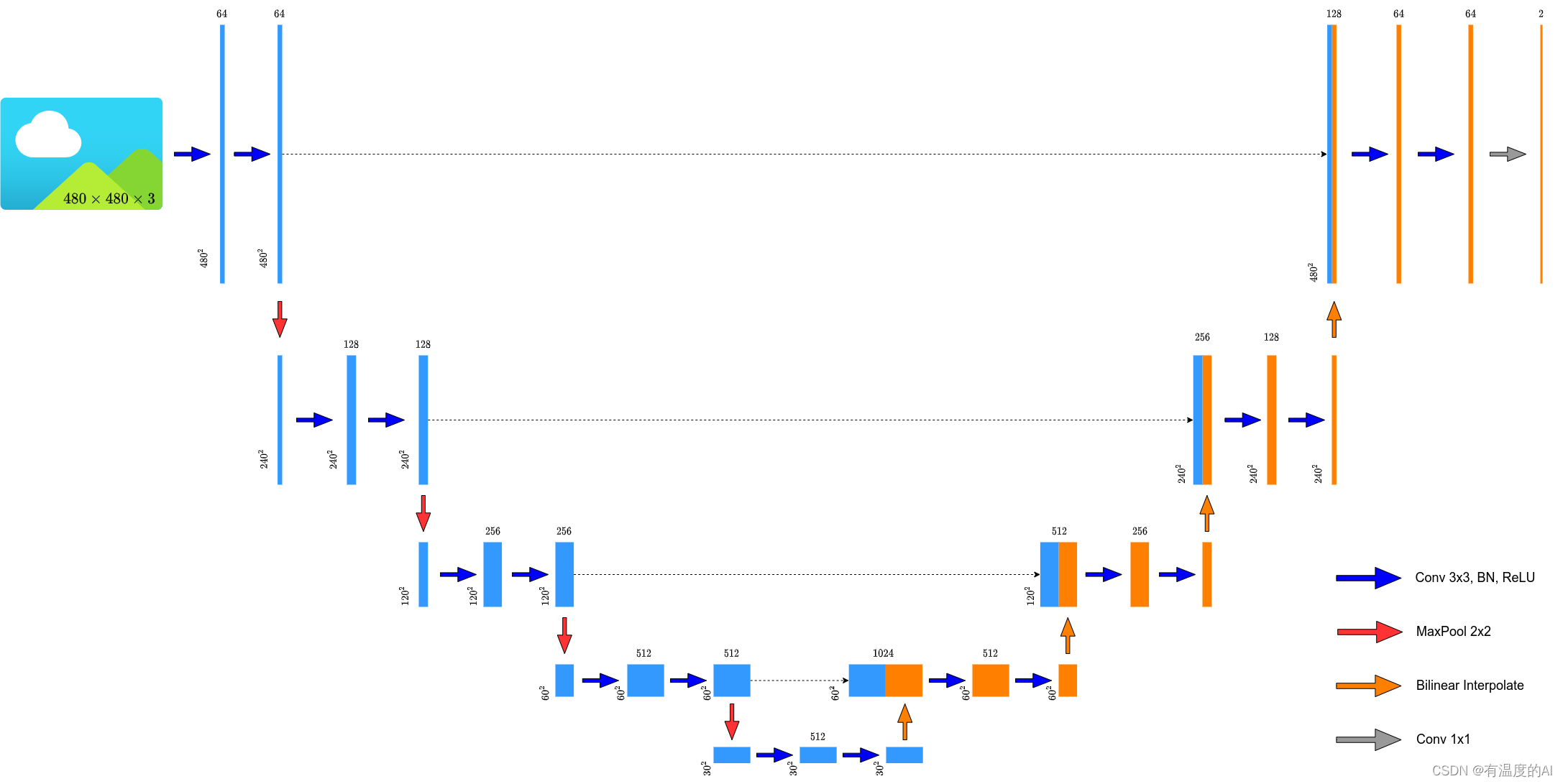-
Unet网络结构搭建

- from typing import Dict
- import torch
- import torch.nn as nn
- class DoubleConv(nn.Sequential): #定义两个串联卷积模块
- def __init__(self, in_channels, out_channels, mid_channels=None):
- if mid_channels is None: #如果没有设置mid_channels,则mid_channels = out_channels
- mid_channels = out_channels
- super(DoubleConv, self).__init__(
- nn.Conv2d(in_channels, mid_channels, kernel_size=3, padding=1, bias=False),
- nn.BatchNorm2d(mid_channels),
- nn.ReLU(inplace=True),
- nn.Conv2d(mid_channels, out_channels, kernel_size=3, padding=1, bias=False),
- nn.BatchNorm2d(out_channels),
- nn.ReLU(inplace=True)
- )
- class Down(nn.Sequential): #定义下采样模块,最大池化+两个串联卷积模块
- def __init__(self, in_channels, out_channels):
- super(Down, self).__init__(
- nn.MaxPool2d(2, stride=2),
- DoubleConv(in_channels, out_channels)
- )
- class Up(nn.Module):
- def __init__(self, in_channels, out_channels, bilinear=True):
- super(Up, self).__init__()
- if bilinear: #双线性插值
- self.up = nn.Upsample(scale_factor=2, mode='bilinear', align_corners=True)
- self.conv = DoubleConv(in_channels, out_channels, in_channels // 2)
- else: #转置卷积
- self.up = nn.ConvTranspose2d(in_channels, in_channels // 2, kernel_size=2, stride=2)
- self.conv = DoubleConv(in_channels, out_channels)
- # Up正向传播过程,先进行上采样,在进行拼接,拼接之后在经过DoubleConv
- def forward(self, x1: torch.Tensor, x2: torch.Tensor) -> torch.Tensor:
- x1 = self.up(x1) #此处只经过Upsample或ConvTranspose2d
- x = torch.cat([x2, x1], dim=1) #x2, x1进行拼接
- x = self.conv(x) #拼接之后在经过DoubleConv
- return x
- class OutConv(nn.Sequential):
- def __init__(self, in_channels, num_classes):
- super(OutConv, self).__init__(
- nn.Conv2d(in_channels, num_classes, kernel_size=1) #1*1卷积调整最后的通道数
- )
- class UNet(nn.Module):
- def __init__(self,
- in_channels: int = 3,
- num_classes: int = 2,
- bilinear: bool = True,
- base_c: int = 64):
- super(UNet, self).__init__()
- self.in_channels = in_channels
- self.num_classes = num_classes
- self.bilinear = bilinear
- self.in_conv = DoubleConv(in_channels, base_c)
- self.down1 = Down(base_c, base_c * 2)
- self.down2 = Down(base_c * 2, base_c * 4)
- self.down3 = Down(base_c * 4, base_c * 8)
- factor = 2 if bilinear else 1
- self.down4 = Down(base_c * 8, base_c * 16 // factor)
- self.up1 = Up(base_c * 16, base_c * 8 // factor, bilinear)
- self.up2 = Up(base_c * 8, base_c * 4 // factor, bilinear)
- self.up3 = Up(base_c * 4, base_c * 2 // factor, bilinear)
- self.up4 = Up(base_c * 2, base_c, bilinear)
- self.out_conv = OutConv(base_c, num_classes)
- def forward(self, x: torch.Tensor) -> Dict[str, torch.Tensor]:
- x1 = self.in_conv(x) # 480*480*3 -> 480*480*64 -> 480*480*64
- x2 = self.down1(x1) # 240*240*64 -> 240*240*128 -> 240*240*128
- x3 = self.down2(x2) # 120*120*128 -> 120*120*256 -> 120*120*256
- x4 = self.down3(x3) # 60*60*256 -> 60*60*512 -> 60*60*512
- x5 = self.down4(x4) # 30*30*512 -> 30*30*512 -> 30*30*512
- x = self.up1(x5, x4) # 60*60*512 -> 60*60*1024 -> 60*60*512 -> 60*60*256
- x = self.up2(x, x3) # 120*120*256 -> 120*120*512 -> 120*120*256 -> 120*120*128
- x = self.up3(x, x2) # 240*240*128 -> 240*240*256 -> 240*240*128 -> 240*240*64
- x = self.up4(x, x1) # 480*480*64 -> 480*480*128 -> 480*480*64 -> 480*480*64
- logits = self.out_conv(x) # 480*480*64-> 480*480*num_classes
- return {"out": logits}
reference
【使用Pytorch搭建U-Net网络并基于DRIVE数据集训练(语义分割)】 https://www.bilibili.com/video/BV1rq4y1w7xM?share_source=copy_web&vd_source=95705b32f23f70b32dfa1721628d5874
-
相关阅读:
Ubuntu Server 22.04.1配置(配置root账号、设置固定IP、更改SSH端口、配置UFW、VM扩展磁盘后Ubuntu的扩容)
HTML+CSS-Day12
Whisper的应用
Java基础——反射
若依(RuoYi )权限管理设计
海外腾讯云服务器手机上无法访问外网怎么办??
产品经理容易犯的八个错误
asp.net饭店订餐管理系统VS开发sqlserver数据库web结构c#编程Microsoft Visual Studio计算机设计定制
微服务框架 SpringCloud微服务架构 16 SpringAMQP 16.3 入门案例的消息接收
Android View体系
- 原文地址:https://blog.csdn.net/m0_56247038/article/details/126992011
